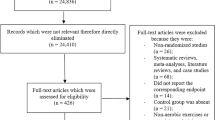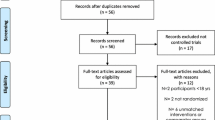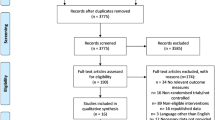Abstract
Aims
To conduct a meta-analysis of head-to-head trials comparing aerobic exercise training of different intensities on glycemic control in type 2 diabetes.
Methods
Databases, including MEDLINE and EMBASE, were searched up to January 2016. Randomized trials of at least 12 weeks in duration that compared two exercise interventions of different intensities were identified. Two reviewers independently extracted data from eligible trials. Using fixed effect model, weighted mean differences (WMD) between different exercise intensities were calculated for changes in glycated hemoglobin (HbA1c) and secondary outcomes, such as fasting glucose and fasting insulin.
Results
Eight studies with a total of 235 participants were eligible. The exercise interventions lasted from 12 weeks to 6 months. The prescribed exercise intensities varied among studies. Four studies utilized vigorous exercise intensities for short durations by performing interval training. Overall, higher-intensity exercise resulted in a greater reduction in HbA1c compared to lower-intensity exercise (WMD = −0.22 %; 95 % confidence interval [−0.38, −0.06]; or −2.4 mmol/mol [−4.15, −0.66], I 2 = 0). Adherence to exercise and proportion of dropouts did not differ within trials. No adverse events were reported in these small trials with selected inclusion criteria.
Conclusions
Although our meta-analysis had a limited sample size, increasing exercise intensity safely accentuated reductions in HbA1c in some people with type 2 diabetes. Different approaches have been used to increase exercise intensity (i.e., some used interval training, whereas others used higher-intensity continuous exercise). However, at this time, it is unclear which form, if any, leads to the most favorable results.





Similar content being viewed by others
References
Boulé NG, Haddad E, Kenny GP, Wells GA, Sigal RJ (2001) Effects of exercise on glycemic control and body mass in type 2 diabetes mellitus: a meta-analysis of controlled clinical trials. J Am Med Assoc: JAMA 286:1218–1227
Umpierre D, Ribeiro PA, Kramer CK et al (2011) Physical activity advice only or structured exercise training and association with HbA1c levels in type 2 diabetes: a systematic review and meta-analysis. JAMA, J Am Med Assoc 305:1790–1799
Thomas DE, Elliott EJ, Naughton GA (2006) Exercise for type 2 diabetes mellitus. Cochrane Database Syst Rev 3:CD002968
Colberg SR, Albright AL, Blissmer BJ et al (2010) Exercise and type 2 diabetes: American College of Sports Medicine and the American Diabetes Association: joint position statement. Exercise and type 2 diabetes. Med Sci Sports Exerc 42:2282–2303
Canadian Diabetes Association Clinical Practice Guidelines Expert C, Sigal RJ, Armstrong MJ, Colby P et al (2013) Physical activity and diabetes. Can J Diabetes 37(1):S40–S44
Yang Z, Scott CA, Mao C, Tang J, Farmer AJ (2014) Resistance exercise versus aerobic exercise for type 2 diabetes: a systematic review and meta-analysis. Sports Med 44:487–499
Schwingshackl L, Missbach B, Dias S, Konig J, Hoffmann G (2014) Impact of different training modalities on glycaemic control and blood lipids in patients with type 2 diabetes: a systematic review and network meta-analysis. Diabetologia 57:1789–1797
Thompson W (2013) Now trending: worldwide survey of fitness trends for 2014. ACSM’S Health Fit J 17:10–20
Weston KS, Wisloff U, Coombes JS (2014) High-intensity interval training in patients with lifestyle-induced cardiometabolic disease: a systematic review and meta-analysis. Br J Sports Med 48:1227–1234
Boulé NG, Kenny GP, Haddad E, Wells GA, Sigal RJ (2003) Meta-analysis of the effect of structured exercise training on cardiorespiratory fitness in Type 2 diabetes mellitus. Diabetologia 46:1071–1081
Umpierre D, Ribeiro PA, Schaan BD, Ribeiro JP (2013) Volume of supervised exercise training impacts glycaemic control in patients with type 2 diabetes: a systematic review with meta-regression analysis. Diabetologia 56:242–251
Garber CE, Blissmer B, Deschenes MR et al (2011) American College of Sports Medicine position stand. Quantity and quality of exercise for developing and maintaining cardiorespiratory, musculoskeletal, and neuromotor fitness in apparently healthy adults: guidance for prescribing exercise. Med Sci Sports Exerc 43:1334–1359
The Cochrane Collaboration (2011) Cochrane handbook for systematic reviews of interventions version 5.1.0 [updated March 2011]. In: Higgins JPT, Green S (eds). http://handbook.cochrane.org. Accessed 28 Oct 2015
Chao M, Liang F, Wang Z, Wang L, Ouyang G, Wang XD (2015) Effects of aerobic exercises in different intensities to the physiological indicators of type 2 diabetes patients. Chin J Rehabil Med 30:883–887
Sgadari A, Broccatelli M, De Bellonia S, Bernabei R (2014) Hi-intensity interval training vs. constant load training: the effects on body composition and endothelial function in patients with type 2 diabetes mellitus. Med Sci Sports Exerc 46:166
Han K, Koo B, Kim H et al (2008) Moderate intensity exercise was more effective in body fat loss, but vigorous exercise improved the insulin resistance in overweight type 2 diabetes mellitus. Diabetologia 51:S269
Han KA, Min KW, Koo BK, Pak KS, Kim HJ, Kim EJ (2009) Effects of moderate versus vigorous intensity exercise training on inflammatory markers, endothelial function, and insulin resistance in the patients with type 2 diabetes: longitudinal study. Diabetes 58:1080
Marianna B, Sgadari A, De Bellonia S, Bernabei R (2014) Hi-intensity interval training and constant load training induce similar muscle force changes in patients with type 2 diabetes mellitus. Med Sci Sports Exerc 46:167
Yoon BK, Park SJ, Cha HR (2012) The effect of different exercise intensities on blood profiles and body composition for type II diabetes. Med Sci Sports Exerc 44:502
Pandey AK, Clarus S, Poirier P (2015) The comprative effect of burst exercise vs. sustained exercise on the cardiometabolic status of newly diagnosed diabetic patients. Can J Cardiol 31:S207
Yan H, Prista A, Ranadive SM et al (2014) Effect of aerobic training on glucose control and blood pressure in T2DDM East African males. ISRN Endocrinol 2014:864897
Jung JY, Han KA, Ahn HJ et al (2012) Effects of aerobic exercise intensity on abdominal and thigh adipose tissue and skeletal muscle attenuation in overweight women with type 2 diabetes mellitus. Diabetes Metab J 36:211–221
Hamed NS, Raoof NALA (2014) Effect of high intensity interval training on diabetic obese women with polyneuropathy: a randomized controlled clinical trial. Phys Ther Rehabil 1:1–8
Hollekim-Strand SM, Bjorgaas MR, Albrektsen G, Tjonna AE, Wisloff U, Ingul CB (2014) High-intensity interval exercise effectively improves cardiac function in patients with type 2 diabetes mellitus and diastolic dysfunction: a randomized controlled trial. J Am Coll Cardiol 64:1758–1760
Ku YH, Koo BK, Ahn HJ et al (2009) Effects of aerobic exercise intensity on insulin resistance in patients with type 2 diabetes mellitus. Korean Diabetes J 33:401–411
Lee SS, Yoo JH, So YS (2015) Effect of the low- versus high-intensity exercise training on endoplasmic reticulum stress and GLP-1 in adolescents with type 2 diabetes mellitus. J Phys Ther Sci 27:3063–3068
Terada T, Friesen A, Chahal BS, Bell GJ, McCargar LJ, Boule NG (2013) Feasibility and preliminary efficacy of high intensity interval training in type 2 diabetes. Diabetes Res Clin Pract 99:120–129
Karstoft K, Winding K, Knudsen SH et al (2013) The effects of free-living interval-walking training on glycemic control, body composition, and physical fitness in type 2 diabetic patients: a randomized, controlled trial. Diabetes Care 36:228–236
Mitranun W, Deerochanawong C, Tanaka H, Suksom D (2014) Continuous vs interval training on glycemic control and macro- and microvascular reactivity in type 2 diabetic patients. Scand J Med Sci Sports 24:e69–e76
Hansen D, Dendale P, Jonkers RA et al (2009) Continuous low- to moderate-intensity exercise training is as effective as moderate- to high-intensity exercise training at lowering blood HbA(1c) in obese type 2 diabetes patients. Diabetologia 52:1789–1797
Li J, Zhang W, Guo Q et al (2012) Duration of exercise as a key determinant of improvement in insulin sensitivity in type 2 diabetes patients. Tohoku J Exp Med 227:289–296
Krause M, Rodrigues-Krause J, O’Hagan C et al (2014) The effects of aerobic exercise training at two different intensities in obesity and type 2 diabetes: implications for oxidative stress, low-grade inflammation and nitric oxide production. Eur J Appl Physiol 114:251–260
Thompson SG, Higgins JPT (2002) How should meta-regression analyses be undertaken and interpreted? Stat Med 21:1559–1573
Snowling NJ, Hopkins WG (2006) Effects of different modes of exercise training on glucose control and risk factors for complications in type 2 diabetic patients: a meta-analysis. Diabetes Care 29:2518–2527
MacLeod SF, Terada T, Chahal BS, Boule NG (2013) Exercise lowers postprandial glucose but not fasting glucose in type 2 diabetes: a meta-analysis of studies using continuous glucose monitoring. Diabetes Metab Res Rev 29:593–603
Jelleyman C, Yates T, O’Donovan G et al (2015) The effects of high-intensity interval training on glucose regulation and insulin resistance: a meta-analysis. Obes Rev 16:942–961
Curry M, Mehta SP, Chaffin JC, Duran E, Washington B, Bose SS (2015) The effect of low-volume, high-intensity interval training on blood glucose markers, anthropometric measurements, and cardiorespiratory fitness in patients with type 2 diabetes. Crit Rev Phys Rehabil Med 27:19–35
Balducci S, Zanuso S, Cardelli P et al (2012) Effect of high- versus low-intensity supervised aerobic and resistance training on modifiable cardiovascular risk factors in type 2 diabetes; the Italian Diabetes and Exercise Study (IDES). PLoS ONE 7:e49297
Acknowledgments
The authors would like to thank Drs. Hansen, Manders, and Karstoft for sharing change-from-baseline standard deviations from their studies. We would also like to thank Linda Slater for performing the computerized literature searches. This study was supported by the University of Alberta, Faculty of Physical Education and Recreation, Physical Activity and Diabetes Laboratory.
Author information
Authors and Affiliations
Corresponding author
Ethics declarations
Conflict of interest
Dr. Terada and Dr. Boulé have received funding and equipment from Medtronic of Canada for projects unrelated to this article. Dr. Terada and Dr. Boulé are the authors of one of the articles included in this meta-analysis.
Ethical standard
All procedures performed in the study by Terada et al. were in accordance with the ethical standards of the University of Alberta Research Ethics Board and with the 1964 Declaration of Helsinki and its later amendments or comparable ethical standards.
Human and animal rights
This article does not contain any studies with human participants or animals performed by any of the authors, with the exception of the eligible and previously published study by Terada et al. [27].
Informed consent
All of the eligible articles included in the meta-analysis stated that they had obtained informed consent from participants.
Additional information
Managed by Massimo Porta.
Electronic supplementary material
Below is the link to the electronic supplementary material.
Rights and permissions
About this article
Cite this article
Liubaoerjijin, Y., Terada, T., Fletcher, K. et al. Effect of aerobic exercise intensity on glycemic control in type 2 diabetes: a meta-analysis of head-to-head randomized trials. Acta Diabetol 53, 769–781 (2016). https://doi.org/10.1007/s00592-016-0870-0
Received:
Accepted:
Published:
Issue Date:
DOI: https://doi.org/10.1007/s00592-016-0870-0




